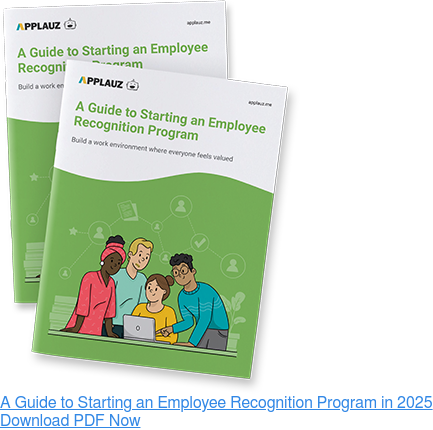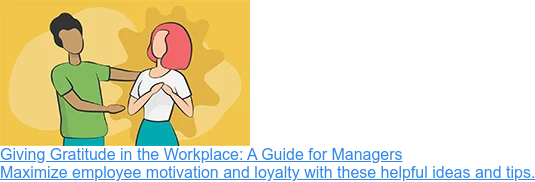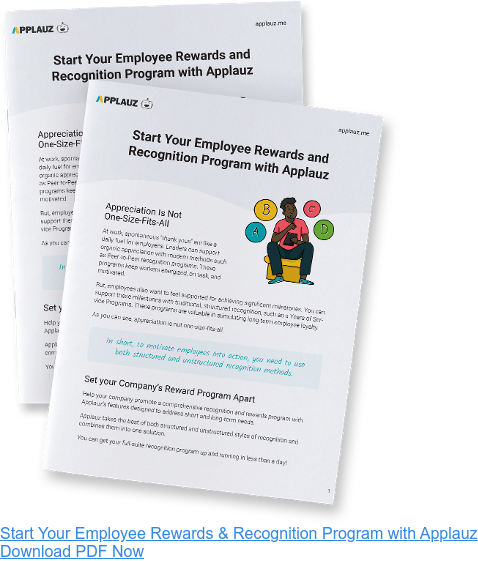MONTHLY NEWSLETTER:
Subscribe and join our community of curious HR Professionals and Managers.
Latest Article
Categories
Quick Links
Applauz Blog
Published: December 2, 2019
Last Updated: February 7, 2024
4 min read

Expressing the power of gratitude at work is a wonderful way to promote stronger bonds between people, leading to higher happiness and engagement.
Turn on your laptop, phone, or TV, and all you will see in 2019 is negative and fear-provoking news. It makes you wonder if happy or positive events happen in the world at all!
The ubiquity of negative news is not a coincidence; journalists and news channels are deliberately exploiting a collective weakness — something more formally known as the negativity bias.
It's true, to a degree, we are hardwired towards negative thinking.
Psychological studies reveal that negative stimuli have a more significant impact on our attention and energy than positive stimuli.
In other words, even when positive things DO happen, we tend to downplay the positive and focus on the negative instead.
Continuous negativity produces a toxic mindset. Fueled by feelings of cynicism, distrust, and fear.
These strong emotions further drive people and groups to isolate themselves. Ultimately, pulling people apart and disconnecting us.
Now, let's back up a bit and tie this idea to organizational culture.
Think about how the negativity bias would play out on a smaller scale, at work or in any organization. It would undoubtedly have the same impact on people's attitudes and feelings about their work.
In short, when negativity begins to colour our perception of the world, it can be a tough mindset to break.


Thankfully, psychological research has found a simple and effective antidote to the negativity bias: gratitude
Gratitude shatters the lens of negativity.
It’s simple: Acknowledge negative events, but intentionally choose to focus on good instead of bad.
At work, this means recognizing the positive intentions and efforts of others. This mindset naturally decreases feelings of distrust.
Many psychological studies prove the power of gratitude across contexts, professional and personal.
A fascinating study looked at the role of gratitude in romantic partnerships.
The study found that when partners verbalized and focused on being grateful for each other’s kind acts (instead of focusing on what their partner didn’t do), both parties felt more connected and satisfied with their relationship.
The same result would likely be found in professional partnerships as well.
The presence of gratitude has an obvious positive effect on all types of relationships across all contexts. Interestingly, a lack of gratitude has an effect on organizations as well.
One 2012 study found that over half of employees were looking for a new job for one reason: They felt under-appreciated in their current job.
Bottom line: The importance of recognition in the workplace is clear. Regularly expressing gratitude serves as a powerful way to promote stronger social bonds between individuals and work teams, ultimately boosting employee motivation and engagement.

At this point, we know gratitude is important. But, the power of gratitude needs to be brought to life through real actions.
That said, here are a few concrete steps you can take today. Let's take this idea off paper and into the real world.
Cultivating a positive environment of gratitude starts at the very top of an organization.
The lesson for HR here might be to hire leaders that already show natural ease with empathy and compassion — two highly important traits of successful leaders.
People who are in positions of leadership should be taking the first step towards expressing appreciation and gratitude. Those around them will naturally follow suit. Observing people in positions of power expressing appreciation, individuals who are less comfortable with being open will grow to see this behaviour as something to admire rather than a weakness.

There are many ways to practice gratitude, but it's not a one-size-fits-all process. Think about a brief, two or three-minute rituals you can implement within teams or departments to help promote gratitude.
For instance, it can be something as simple as writing down what you are grateful for. In Psychology Today, Christopher Bergland reports on a new study that showed how gratitude journaling helped to reduce incivility, gossip, and ostracism in the workplace.
Alternatively, teams can host 'appreciation huddles' every week or month. Employees would be encouraged to articulate what they were grateful for and offer recognition to coworkers who helped them out.
Cultivating a positive and engaging environment begins with expressing gratitude beyond what people do at your company.
In short, workers should be appreciated for more than accomplishing their day-to-day responsibilities. Instead, focus on expressing gratitude for their unique insights, skills, contributions, and also for their personality.
Expressing gratitude for someone’s “soft” skills like their contagious positive attitude and sense of humour, or keen ability to think critically, is a great way to ensure gratitude is sincere and genuine.
This tip is not about what you say, but how you’re saying it. You can give praise publicly, privately, over email, chat, face-to-face, or in a group meeting.
In short, there are countless ways to give praise. So make sure to express gratitude and appreciation in a way (and via a medium) that will respect and resonate with each employee.
There are many different reasons to give employees recognition. As such, expressing your gratitude shouldn’t be limited to a small group of people. It's not a popularity contest.
To avoid this, express gratitude for different types of actions and accomplishments. And express gratitude to individuals who occupy less visible (but critical) roles in a company as well.
It’s easy to show appreciation for a developer that pushes a new feature, but what about the people behind the scenes? Those who stay late organizing social events, or the staff in the warehouse, or IT support that sets up all the systems that allow people to actually do their work every day.
For a culture of appreciation and gratitude to truly flourish, express gratitude to everyone, for actions big and small.
The employees that make up your company spend most of the day with their coworkers. So, while giving top-down recognition is important, a Peer-to-Peer recognition system will help to weave gratitude into your entire work culture.
If employee recognition is important to your goals, consider rolling-out an official Peer-to-Peer program. Prioritizing employee recognition with an official system has been shown to have a healthy and positive impact on employee engagement and happiness.


You might be thinking these ideas are great, but my employees have a hard time expressing themselves.
This attitude is common. For most of history, the relationships between employees and organizations were transactional — I give you labour, you provide me with compensation. In other words, there's no room for emotions at work.
We don't live in industrial times anymore. Nonetheless, these lingering stereotypes about emotions at work hold employees back. For instance, employees may believe that it might be awkward or make the other person feel uncomfortable.
A psychological study even showed 35% of respondents believed that expressing gratitude at work could lead coworkers to take advantage of them!
Gratitude has shown to benefit job satisfaction, collaboration, and productivity; yet, people still have difficulty with workplace vulnerability.
For empathetic people, recognizing others comes easily. But for others, expressing appreciation can feel uncomfortable if not downright awkward.
Discomfort showing appreciation (and vulnerability) in a professional context is a real issue that is supported by research.
The key to reducing discomfort is simple: consistency and effort. It all starts with embracing new habits and rituals. And it can only begin when leaders are involved. In other words, it all starts at the top — with leaders, managers, and supervisors taking the first steps.
Category Tags
Employee Recognition
MONTHLY NEWSLETTER:
Subscribe and join our community of curious HR Professionals and Managers.

7675 Blvd Saint-Laurent,
suite 201,
Montreal, QC,
CA, H2R 1W9
7675 Blvd Saint-Laurent, suite 201, Montreal, QC, CA, H2R 1W9
Contact us
1 833 277 5289
Contact us | 1 833 277 5289
Follow us on LinkedIn:
© Copyright 2024. All Rights Reserved